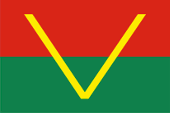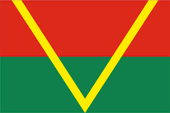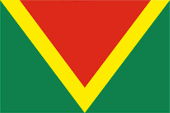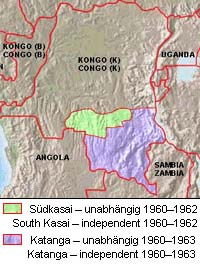Süd-Kasai |
|
|
|
| Übersicht – Contents: | |
Diese Seite ist Teil des Projektes
Süd-Kasai |
|
|
|
| Übersicht – Contents: | |
Flagge – Flag: |
|
 |
Nationalflagge – national flag, |
 |
Nationalflagge – national flag, |
 |
fehlerhafte und häufig gebrauchte Variante der Nationalflagge – incorrect and frequently used variant of the national flag, Quelle/Source: Flags of the World |
Bedeutung/Ursprung der Flagge – Meaning/Origin of the Flag: |
|
| Die Flagge von Südkasai zeigte zwei horizontale Streifen in Rot und Grün und in der Mitte der Flagge ein gelbes "V". | The flag of South Kasai showed two horizontal stripes in red and green and in the middle of the flag an yellow "V". |
| Einige Quellen zeigen das gelbe V bis an den Rand der Flagge reichend, andere (so auch Fotos) zeigen es nicht bis zum Rand reichend. | Some sources show the V reaching to the edge of the flag, other (even fotos) show it not reaching to the edge. |
| Grün, Gelb und Rot sind auch als die "Panafrikanischen Farben" bekannt: Etwa 1900 setzte die Panafrika-Bewegung ein, die Gemeinsamkeiten aller Menschen mit schwarzer Hautfarbe hervorheben wollte. Der Farbendreiklang Grün-Gelb-Rot, den viele afrikanische und auch amerikanische Staaten nach Erlangung ihrer Unabhängigkeit in ihre Flaggen übernahmen, steht für die politische Einheit Afrikas, ja aller Schwarzen. Das erste Land war Ghana im Jahr 1957. Als Ursprung gelten die Landesfarben von Athiopien (Abessinien), dem ältesten unabhängigen Staat Afrikas. | Green,
yellow and red are even known as the "Panafrican colors": Perhaps in 1900
was the beginning of the Panafrica-Movement, wich wants to emphasize the
commons of all people with black skin. The colour-triad green-yellow-red,
wich used many african and even american countries in their flags after the
independence, stands for the political unity of Africa, of all black People. The first country was Ghana in 1957. As the origin apply the colours of Ethiopia (Abessinia), the oldest independent state in Africa. |
| Von der Flagge Südkasais gibt es eine fehlerhafte Variante, die Rot und Grün ober- bzw. unterhalb des "V" zeigt. Sie ist wahrscheinlich auf eine falsche mündliche Interpretation zurückzuführen. Dennoch ist sie häufig zu sehen. | From the
flag of South Kasai exists a defective variant which red and green shows
above respectively below the "V". It has ist roots possibly in a wrong oral interpretation. Nevertheless it is frequently to see. |
| Quelle/Source, nach/by: Flags of the World, Volker Preuß | |
Wappen – Coat of Arms: |
|
 |
1960–1962, Wappen von Süd-Kasai – coat of arms of South Kasai, Quelle/Source, nach/by: www.congoposte.be, Dank an: antemister |
Bedeutung/Ursprung des Wappens – Meaning/Origin of the Coat of Arms: |
|
| Das Wappen von Südkasai zeigte einen Leopardenkopf. Die obige Darstellung wurde einer Briefmarke nachempfunden, die das gleiche Wappen trug wie die Verfassung des Landes. | The coat
of arms of South Kasai showed a head of a leopard. The above depiction was
derived by a stamp, which showed the same coat of arms like the constitution
of the state. |
| Quelle/Source, nach/by: www.congoposte.be, Dank an: antemister | |
Landkarte: |
 Quelle/Source: Freeware, University of Texas Libraries, modyfied by: Volker Preuß |
Zahlen und Fakten – Numbers and Facts: |
|
|
|
|
|
|
|
|
|
|
|
|
|
|
|
Geschichte: |
| Vor der Eroberung des Kongo durch die Belgier existierte in Kasai zwischen dem 15. und 19. Jahrhundert das Reich der Kuba und die südlichen Landesteile gehörten zum Lubareich von Katanga. Kasai wurde dann eine Provinz von Belgisch-Kongo (heute Kongo-Kinshasa [Zaire]). Im Zuge der Bürgerkriegswirren vor und nach der Unabhängigkeitserklärung von Kongo-Kinshasa (30.06.1960) erklärte sich der an Bodenschätzen reiche Süden der Kasai-Provinz am 14.06.1960 als "Autonomer Staat Südkasai" unter dem Lubaführer Albert Kalonji für unabhängig. Am 08.08.1960 wurde der "Autonome Bergbaustaat Südkasai" proklamiert. Zur Hauptstadt wurde Bakwanga (das heutige Mbuji-Mayi) erklärt. Am 12.04.1961 wurde der Vater von Albert Kalonji von den Luba als König eingesetzt, der sein Amt sofort an seinen Sohn übergab. Präsident Kalonji nannte sich jetzt Mulopwe (König) Albert I. Kalonji. Durch Angriffe der Truppen des Kongo-Ministerpräsidenten Lumumba bzw. dessen Nachfolgers Gizenga gingen die Städte Bakwanga und Loulabourg verloren und Albert I. geriet in Gefangenschaft. In der Zwischenzeit unterlagen die Truppen Gizengas den Truppen von Joseph Mobuto und Moise Tschombe. Am 07.09.1962 gelang es Albert I. aus der Gefangenschaft zu fliehen und er kehrte an die Spitze seines ums Überleben kämpfenden Staates zurück, jedoch musste Südkasai nur einen Monat später kapitulieren. Die Regierung Mobuto teilte die Provinz Kasai in eine Ostprovinz (Hauptstadt Mbuji-Mayi) und eine Westprovinz Hauptstadt (Luluabourg/Kananga). |
History: |
| Before the conquest of Kongo by the Belgians existed in Kasai between the 15th and 19th century the Empire of the Kuba and the southern parts of the country belonged to the Luba-Empire of Katanga. Kasai became then a province of Belgian-Congo (today Congo-Kinshasa [Zaire]). During the confusions of the civil war before and after the declaration of independence of Congo-Kinshasa (30th of June 1960) declared the in mineral resources rich south of the province of Kasai its independence on the 14th of June in 1960 as "Autonomous State of South Kasai" under the Luba-Leader Albert Kalonji. On 8th of August in 1960 was proclaimed the "Autonomous Mining State of South Kasai". Capital became Bakwanga (the today’s Mbuji-Mayi). On 12th of April in 1961 the father of Albert Kalonji was proclaimed by the Luba as king, which his title immediately handed over to his son. President Kalonji named itself now Mulopwe (King) Albert I. Kalonji. Because of attacks of the troops of the premier of Congo-Kinshasa Lumumba resp. its successor Gizenga the cities of Bakwanga and Loulabourg were lost and Albert I. was captured. In the meantime the troops of Gizengas lose against the troops of Joseph Mobuto and Moise Chombe. On 7th of September in 1962 Albert I. succeeded in escaping from the imprisonment and he returned to the top of his for surviving fighting state, but South Kasai has to surrender only one month later. The Mobuto-Government partitioned the province of Kasai in a eastern province (capital Mbuji-Mayi) and a western province (capital Luluabourg/Kananga). |
| Quelle/Source: Wikipedia (D), Volker Preuß |
Ursprung des Landesnamens – Origin of the Country's Name: |
|
| Der
Landesname "Kasai" bzw. "Süd-Kasai" geht auf den Fluss Kasai zurück, der im
Lundaland in Angola seine Quelle hat. Er fließt zunächst nordwärts und dann
Richtung Nordwesten und vereinigt sich als "Kwa" bei der Ortschaft Kwamouth
mit dem Fluss Kongo. |
The country's name "Kasai" resp. "South Kasai" has its roots in the name of the Kasai River, which has its spring in the Lunda Country in Angola. It streams initially northwards and then in northwestern direction and unites as "Kwa" near the place Kwamouth with the Kongo River. |
| Quelle/Source: Volker Preuß | |